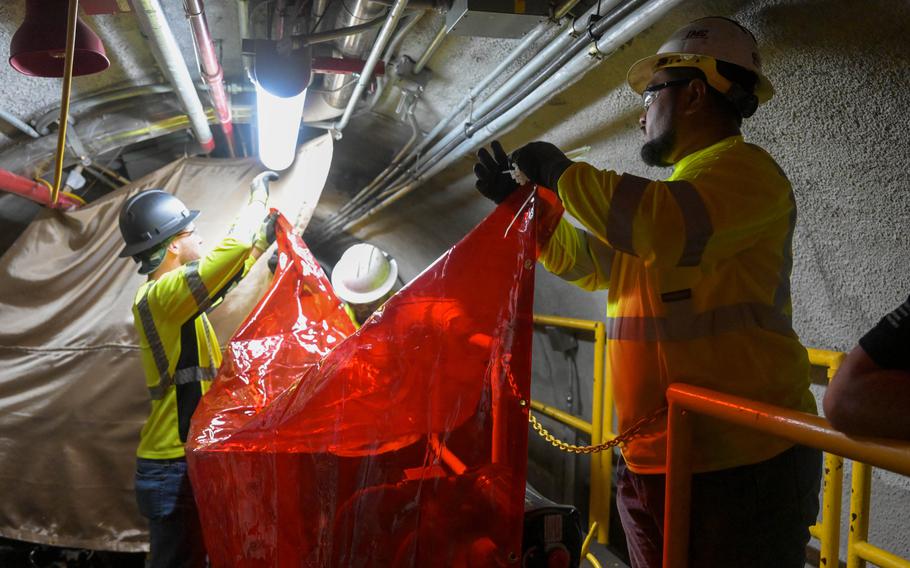
Workers with Joint Task Force-Red Hill set up protective curtains before cutting into pipelines at the Red Hill Bulk Fuel Storage Facility in Hawaii on March 11, 2024. (ZaBarr Jones/U.S. Department of Defense)
FORT SHAFTER, Hawaii — The Navy on Thursday assumed full oversight of the permanent closure of the Red Hill Bulk Fuel Storage Facility in Hawaii and the long-term cleanup of petroleum contaminated soil and groundwater left after decades of use.
Joint Task Force-Red Hill, the Defense Department entity that had been tasked with emptying roughly 104.4 million gallons of fuel from the facility, transferred responsibility to the Navy Closure Task Force during a ceremony at Ford Island.
“As you know, for more than 80 years, the facility has kept our ships sailing and kept our aircraft flying,” Rear Adm. Stephen Barnett, who commands the Navy task force as well as Navy Region Hawaii, told the audience.
“It’s enabled the United States of America to safeguard our nation and its most important assets: our people. But right now, today, it’s time for us to move to the next phase. To do this, Navy Closure Task Force will safely, expeditiously decommission this facility.”
Defense Secretary Lloyd Austin in March 2022 ordered the World War II-era facility permanently closed after a jet fuel leak contaminated the Navy’s water distribution system in late 2021.
Thousands of people living in military housing communities on or near Joint Base Pearl Harbor-Hickam were forced to temporarily relocate as the Navy flushed the entire system.
Hundreds of residents and former residents have filed suit in federal court seeking compensation for medical conditions and other hardships they say arise from the contamination.
The Defense Department established Joint Task Force-Red Hill to empty the 20 massive underground tanks, which first required extensive repair and upgrading of pipelines to preclude any leaks during defueling.
Some members of the first task force have been transitioning to the Navy group over the past few months.
‘Candidly, frequently, transparently’
The Navy task force will remove about 4,000 gallons of residual fuel in the pipelines accessible only by destroying or dismantling the infrastructure. The Navy task force will undertake the multiyear task of emptying about 28,000 gallons of sludge at the bottom of the tanks, cleaning them and removing contaminants that have leeched into the soil and aquifer.
“The Department of Defense and the United States Navy remain deeply committed to protecting the public’s health and preserving the environment,” Austin said in Pentagon news release Thursday. “Rear Admiral Barnett is determined to close Red Hill safely, and I’ve directed him to continue to communicate with our personnel and the people of Hawaii candidly, frequently, and transparently.”
Some critics, however, say that the Navy has not been as open to communication as it should be, particularly regarding the service’s participation in recent meetings of the Red Hill Community Representative Initiative, or CRI.
The 10-member group was established last year by federal consent order to liaison directly with the Navy, U.S. Environmental Protection Agency and Defense Logistics Agency regarding issues of the facility’s closure and water quality.
Navy officials skipped the January meeting and in a Jan. 16 news release called for revising “operating procedures and ground rules that will ensure civil discussion among CRI participants” for future meetings.
Navy officials attended the February meeting, but in a March 18 release, the service said the meeting “did not live up” to its standards of “a safe and respectful information sharing forum.”
Marti Townsend, the CRI chairwoman, responded with a terse statement the same day.
“The Navy’s attempt to strong-arm the CRI is a significant setback in the Navy’s stated mission to rebuild trust with the people of O’ahu after their water supply was permanently poisoned by a jet fuel spill from Red Hill,” she said.
Kathleen Ho, director for environmental health for the Hawaii Department of Health, the state entity overseeing the closure, congratulated the commanders of both task forces Thursday for the work done so far.
“Although we concur that the [Joint Task Force-Red Hill’s] defueling obligations are complete, there is still much work to be done to permanently close the Red Hill facility and remediate the environment,” Ho wrote in a letter.
The department will hold the Navy Closure Task Force-Red Hill “accountable to complete this work and expect that they will execute these tasks with the same diligence and commitment to community involvement exhibited by [Joint Task Force-Red Hill],” she wrote.